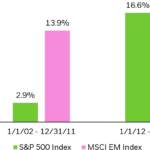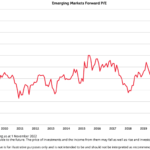The acronym BRICs refers to the emerging economies of Brazil, Russia, China and India. It was coined by Goldman Sachs in 2001.
Today The Financial Times had a piece titled “S&P; calls for Brics break-up“. The gist of S&P;’s call was that these countries should not be grouped together now as a single asset class because their outlook has diverged after the credit crisis. I totally agree with this assessment. All these four countries have different dynamics that it does not make sense to group them together.
S&P; also stated “whether the Bric countries ever shared much in common other than scale and high portfolio inflows.” Of course these countries did not have a lot in common other than the huge flow of foreign capital in their equity and debt markets. Lets take a quick look at some of the differences between these four countries.
1. Brazil
As a commodity exporter Brazil enjoyed a huge boom in the past few years. As the demand for commodities from countries like China and India soared Brazil benefited from it. Abundant with many natural resources and a relatively small population Brazil’s economy is dependent on the commodity prices. In general the economy is diverse and exports range from planes and cars to a wide range of commodities. On the political front Brazil is a democratic state with a free press unlike China and Russia.
2.Russia
Though considered a democratic country by some, Russia is actually an authoritarian state with no free press. In recent months many journalists who criticized the government have been murdered. Some of the biggest companies are under the control of the state. For example, the largest natural gas exporter in the world Gazprom is under the direct control of the government which owns over 50% of shares. As a large producer and exporter of crude oil, Russia gained immensely as the price of crude went over $140 last year. However in recent months Russia’s fortune has fallen together with the price of crude. The Rouble is collapsing and the stock market plunged last year due to the flight of foreign capital. In 2008 the Russian market fell a whopping 72.41% (Source: 2008 Country Returns ). Unless the price of crude rebounds the Russian economy may continue to suffer. The global credit crisis adds more woes to Russia’s problems.
3. India
S&P; says “India’s case is somewhere in between. It has experienced much higher growth rates than Brazil, but its public finances are also shaky”. As the world’s largest democracy the Indian economy had an incredible boom after the country liberalized the economy in the 90s. However the political system is unstable and corrupt. Foreign portfolio investments has dried up almost completely. India does not have much natural resources and is a net importer of many commodities such as crude, natural gas, etc. As foreigners pulled out of Indian equities, last year the main market index fell by 52.25%. India has a huge foreign debt ($221B in September 2008 – Source: Reuters) that continues to grow as government due to bloated public sector and subsidies. For example, last year the government ordered banks to waive all outstanding loans owed by farmers.
4. China
S&P; said “China is probably best positioned to find solutions in particular fiscal stimulus, to withstand an externally driven crisis.” Some of the reasons given for this assessment are a closed financial system, strong budget and low debt. In my view, China’s economy will not fare much better than other BRIC countries since China’s economy is dependent on exports to the US and Europe. On Feb 2nd, BBC reported that “20 million migrant workers have lost their jobs during the economic downturn“. While the government has announced a large stimulus package of $600B last year much of the details are not clear and some are questioning whether the amount is inflated. Even if the government invests this much money in infrastructure projects it is highly unlikely that the economy will improve quickly. The domestic consumption will not compensate for the fall in demand of its manufactured products in developed countries.



